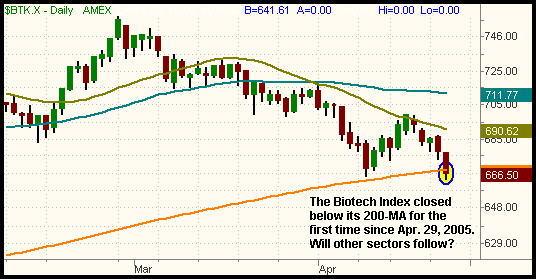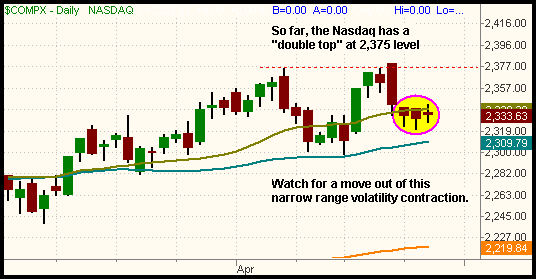2 sectors that could follow Biotech lower
The Nasdaq snapped its four day losing streak yesterday, but the market’s recovery attempt lacked momentum and the gains were nominal. The S&P 500 and Nasdaq Composite moved higher throughout the first hour of trading, but both indices reversed after running into resistance of their prior day’s highs. After subsequently drifting lower throughout the remainder of the session, the Nasdaq finished only 0.1% higher, while the S&P gained 0.3%. An eight percent gain in General Motors helped the Dow Jones Industrial Average to show relative strength and rally 0.6%, but weakness in the mid-cap stocks caused the S&P Midcap 400 Index to fall 0.4%. The small-cap Russell 2000 Index was unchanged.
Total volume in the NYSE increased by 2% yesterday, but volume in the Nasdaq was 9% lower than the previous day’s level. Technically, the S&P’s gain on higher volume registered as a bullish “accumulation day.” However, given that the index trended lower throughout the session, closed near its intraday low, and only managed to advance 0.1%, it is a bit of a stretch to label the day as one of institutional accumulation. Rather, the session had more the feeling of a modest technical bounce. Lackluster market internals also failed to confirm any signs of strength in the market yesterday. In both exchanges, advancing volume exceeded declining volume by less than 3 to 2. A healthy rally will normally see this ratio positive by at least 2 to 1.
In yesterday’s Wagner Daily, we discussed the continued relative weakness
in the Biotech Index
(
BTK |
Quote |
Chart |
News |
PowerRating). Despite a modest gain in the broad market, the BTK completely bucked the trend and slid another 1.8% yesterday. More importantly, the loss caused the index to close below support of its 200-day moving average for the first time in nearly a year (April 29, 2005 to be exact):

The break of its 200-day MA indicates a long-term change in sentiment within the Biotech Index. All three of the primary Biotech ETFs
are also trading below their 200-MAs as well: iShares Biotech
(
IBB |
Quote |
Chart |
News |
PowerRating), PowerShares
Biotech
(
PBE |
Quote |
Chart |
News |
PowerRating), and Biotech HOLDR
(
BBH |
Quote |
Chart |
News |
PowerRating). When an index is trading below its 200-MA, your odds of making a profitable trade on the long side are greatly diminished. Will other sectors soon follow suit as well? The Goldman Sachs Internet Index
(
GIN |
Quote |
Chart |
News |
PowerRating) closed only 1.1% above its 200-MA, while the heavily weighted
Semiconductor Index
(
SOX |
Quote |
Chart |
News |
PowerRating) is sitting only 4.7% above its 200-day MA. If
either of these sectors follow the negative lead of the BTK, it will create a lot of pressure on the Nasdaq and could result in a “series of unfortunate events.” Of course, this has not happened yet, but a cautious stance is warranted when so many sectors in the Nasdaq could slide below their 200-MAs within only one or two bad days.
The market is certainly not weak enough to recommend avoiding the long side of the market, but just focus on the sectors with relative strength. Specifically, avoid the Nasdaq and focus on the S&P and Dow related sectors instead. Obviously, gold, oil, and metals continue to ignore the market’s recent weakness and are trading sideways to higher while the markets drift lower.
As for the broad market, the 1,310 area continues to be a major area of resistance on the S&P. The index rallied above that level last week, but came right back down after only two days above it. But while the 1,310 area acts like a brick wall overhead, the 20-day moving average is currently providing support, as should the 50-day MA nine points below. Be prepared for a rapid move out of this tight range in either direction:

The Nasdaq is an equally tight range right now, stuck between its 20- and 50-day
moving averages:

As of the time of this writing, both the S&P and Nasdaq futures are gapping down more than 0.5% from yesterday’s closing prices. If the futures remain weak, most of the indices will open below their April 25 lows. As the charts above illustrate, that could lead to a break of support in the broad market. However, let’s not forget that we have seen numerous failed breakdowns and breakouts over the past several months, so keep tight stops if you short anything on the open. If the broad market fails to reverse from the opening gap down after the first hour of trading, odds are good that we will continue lower, but a reversal on the open would be bullish.
Open ETF positions:
Short IYR (regular subscribers to The Wagner Daily receive detailed stop and target prices on open positions and detailed setup information on new ETF trade entry prices. Intraday e-mail alerts are also sent as needed.)
Deron Wagner is the head trader of Morpheus Capital Hedge Fund and founder of Morpheus Trading Group (morpheustrading.com), which he launched in 2001. Wagner appears on his best-selling video, Sector Trading Strategies (Marketplace Books, June 2002), and is co-author of both The Long-Term Day Trader (Career Press, April 2000) and The After-Hours Trader (McGraw Hill, August 2000). Past television appearances include CNBC, ABC, and Yahoo! FinanceVision. He is also a frequent guest speaker at various trading and financial conferences around the world. For a free trial to the full version of The Wagner Daily or to learn about Deron’s other services, visit morpheustrading.com or send an e-mail to deron@morpheustrading.com.
